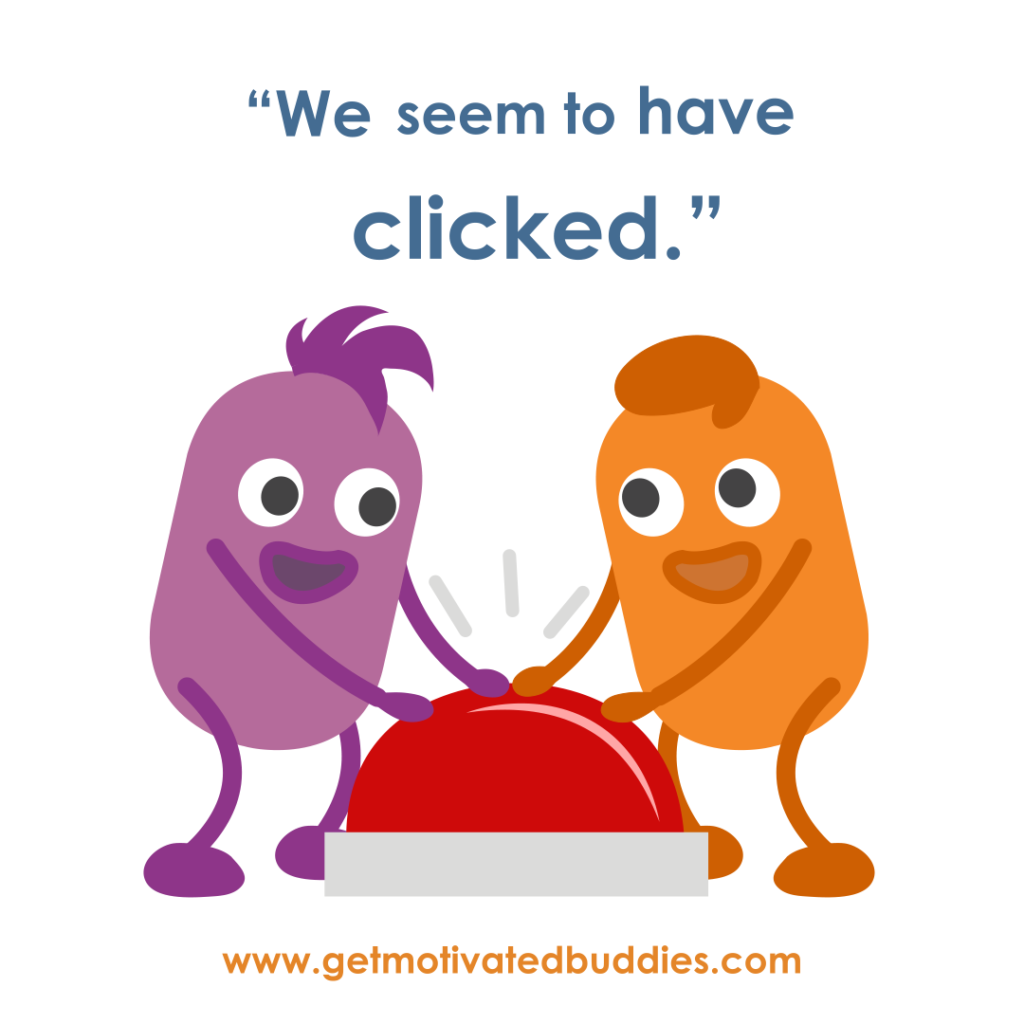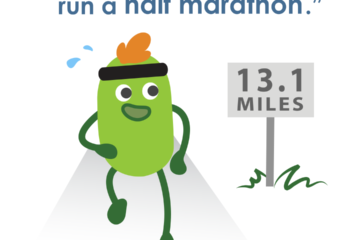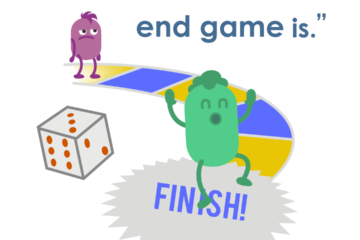Ten Guidelines for Working with An Accountability Partner
I have matched thousands of accountability partners around the world, and most partnerships only last a few weeks, so here are ten Accountability Buddy Best Practices to give you the best chance for success in changing your behavior. If you’re looking for help structuring resolutions, read this article.

1) Don’t use a friend or family member.
There are too many patterns to deal with, too much emotional involvement, and in general, they aren’t committed to you changing. Start with someone new who’s committed to change as well.
2) Choose someone working on the same or similar goal.
The sad truth is that you just won’t care as much about what the other person is working on if it isn’t related to what you’re doing. You want to be invested in what they’re doing. Working with someone who’s working towards something similar to you encourages healthy, friendly competition, and gives you a frame of reference.
3) Plan and Set
- A regular time to connect
- How you’ll connect
- Put it in your calendar
- Treat it as Fixed
Ideally, you have a fixed and regular appointment so you get used to it, but if it’s not planned and in your calendar, it’s not going to happen. You think it will, but it won’t. Once you start changing meeting times or it’s not planned, say goodbye to the partnership and to your habit. Treat that time as an appointment with someone that can’t be changed.
4) If your buddy starts to disappear or misses a scheduled time more than once – politely end the partnership.
Most accountability partnerships don’t last because someone flakes out. (That’s why most people need an accountability partner – to stop flaking out – but c’est la vie.) Once one person stops communicating and it’s acceptable, then the other person does; then everyone pretends they’re doing accountability and you end up just wasting your time. Time is precious. Especially if you’re working on the things that are important to you. *You* need to take responsibility and either email or say, “Thanks so much for agreeing to work together, but unfortunately this isn’t working out for me, so I need to end the partnership.” Then you can find someone else who is more compatible.
5) Choose One Thing to work on.
I can’t tell you how many people want to work on everything all at once and they fail. I’m guilty of this too (thank you, ADHD), but it’s a fail. If you’re looking to build sustainable habits, choose one habit at a time.
You can choose one habit one week, and another the next week, but people who say, “I want to work out three times this week, read 4 hours a day, cook dinner for myself and my friend etc. etc”, will fail. It’s a bad use of an accountability partner, because no one wants to hear a litany of things you did or didn’t do. (“So today, I did work out but only for 20 minutes, but I didn’t read; I did walk the dog, but I didn’t make dinner,” etc. That will not be a long lasting partnership). There’s nothing helpful you or the partner can do.
Choose one activity: i.e. This week I will write my novel for at least 15 minutes three times. (smaller is even better – i.e. 1, 5 or 10 minutes for things that are difficult for us). Then when you communicate, you either did or didn’t do it, and can look at why you did or didn’t do that one task without over thinking it. That’s the only way you’ll get clarity. The GetMotivatedBuddies platform helps you accomplish this.
6) Make your habit *tiny*.
Based on the Tiny Habits technique developed by a mentor of mine, psychologist BJ Fogg at Stanford, make your activity tiny so you can win. Winning is everything when building habits.
Every time you fail to do your habit, you reinforce a pattern of failing to do that behavior. If you already had resistance to it, you reinforce that resistance, and increase it. So the next time you try to do it, you have even more resistance to it. So when you create activities that are difficult to do, you’re actually harming yourself.
To decrease the resistance make it incredibly easy and a sure win. Instead of doing 50 push ups five days a week, do ONE push up. (Anything more is purely extra credit!) Then the next week do two.
Want to go to the gym regularly and you don’t go at all now? Then say “on Wednesday at 5 pm I will go to the gym for five minutes. All I have to do is park my car there.” And when you get there, that’s a win! Anything else you do is pure extra credit. When building new habits your goal is to have many small repeated wins. This is positive reinforcement, and the only thing that will get you to continue.
(That’s how I got myself swimming daily. I started with “I’m going to get in the pool for five minutes.” My only goal was to get into the pool. Of course, once I was there it seemed silly to get out, and I swam for much longer. I ended up swimming half an hour a day for many years).
The platform of GetMotivatedBuddies helps you build your behaviors in this way.
7) Communication: Base all your communication around positive reinforcement.
This doesn’t mean everyone is wonderful and everything is good. This means every step in the right direction towards your goals should be rewarded.
Thought about going to the gym today? = Good job! Started walking towards the door to the gym? = Great work!
If you have resistance towards your goal, even thinking about your habit counts and should be reinforced. Then you can build on that. We need that positive reinforcement for the things that are difficult.
(Example: In Navy Seal mental toughness books, they all mention that Seals get through basic training not by thinking of the 5 days and nights they go without sleep. They think of that very next step, that very next minute, then the next one, and the next one, until they’ve reached that height they didn’t even know they could get to.”)
8) Set a length of time for your check-ins.
If you use some sort of voice or video check in system set a *firm* time frame for the conversation: 5 minutes, 10 minutes, whatever you think you need. Treat it as a deadline so you convey what you need within that time frame.
It’s interesting how when setting appointments between two people we feel comfortable setting start times, but less so setting end times. (There’s a psychological component of what the length of time says about how you think about the person, etc), but for now, as you set up the rules for your partnership, set a time frame up at the beginning.
Our platform provides communication that allows you to remain anonymous and accountable. Texting, whatsapp, phone doesn’t work over time for a host of reasons. Our chat system does.
9) Adjust accordingly.
All of these elements should be adjusted to suit your needs as you work together. If you connect daily, perhaps you discover you only need to connect twice a week. if you speak for ten minutes a day, maybe you realize you only need five. See what’s working for *you*, and if each partner is responsible for their own needs and articulates them clearly – you’ll be well on your way to a successful partnership and greater clarity in your life.
The GetMotivatedBuddies platform allows you to always see how your Buddy is doing without asking for updates. So when you connect, you talk about how you’re doing, what your struggles are, what your successes are, and how you each can improve. There is no judgement, no “shoulds” and limited advice. A good Buddy relationship is about sharing, listening and self-reflection.
10) Remember: Nothing is permanent.
You can always change your plans, your goals, and even your partner if you find they are not working for you. This process is about self-growth, learning what inspires you and gives you energy to keep moving forward. In the end you want to make sure you are gaining something significant from the process of working towards your goals.
Looking for behavioral plans, challenges and an international, supportive community of buddies? Sign up:



9 Comments
Liz Relim · at 1:01 pm
I don’t have a problem in the planning of large goals or the tiny steps needed in the daily beginning of the process. I am in need of the “gun that starts the race”, the yelling/cheering that sparks the skier to jump onto the downhill run, the turn of the key in the ignition. The gradual process described in just thinking of the project or just driving the car and parking it, is a really great starter, but the old powerful messages of waiting for permission are at work here and being addressed. In the meantime I need bills paid and insurance issues dealt with. I just need someone to say: “do it” and I’ll be busy on it and finish what can be done that day. The following day I need the “ignition starter” again. Any experience with this debilitating problem?
Michael G. · at 1:34 pm
You are addressing the core of the problem: the relationship between planning something and actually doing it. You seem to be saying you have no trouble planning, in fact you’re a master of it, but when it comes to the moment of doing, you need help, some trigger – a gun sound, a cheer, a key which ignites a spark. I wrote about this in my first blog post here: https://www.getmotivatedbuddies.com/i-dont-have-an-issue-planning-i-have-an-issue-sticking-to-my-plans/.
The “ignition starter,” the “spark” or the “fire” is what we would call motivation, aka that “feeling” to do what we’ve planned.
The fundamental problem is feelings are unreliable. They change daily, hourly, by the second; so we can not rely on the feeling of motivation to do something.
BJ Fogg, a behavioral psychologist at Stanford, has focused on this relationship in his equation: B = MAT (Behavior = Motivation*Ability*Trigger), and suggests that motivation (feeling) is the most difficult of the variables to control. So in order for a behavior to occur we need to focus on the Ability to do the behavior as well as the Trigger.
His conclusion: make the behavior as TINY, as easy to do as possible, so you win *no matter how you feel.* His course Tiny Habits, http://www.tinyhabits.com, explores this dynamic (I got certified in it).
I’ll write another post about tiny habits in the future but for now:
While breaking down a large goal into small steps is useful, the effective portion is breaking down your behavior into a *very tiny one*, one that you can easily win. In my swimming habit example, just putting your swimsuit by the door = A BIG WIN, and should be celebrated. Is that too tough? Then just taking your swimsuit out of the drawer = A BIG WIN.
Rather than worry about the ignition, and the need to feel the spark, find the tiniest movement you can make towards your goal, and celebrate that movement. Make it as easy and winnable as possible. Simply starting from where you are and doing what you can do without judgement is the best and surest way forward.
8 Strategies For Cultivating Your Seed Habit – The Best Sellers · at 8:14 am
[…] increase your chances of successfully meeting your goals by 95%. This excellent article provides ten guidelines for working with an accountability buddy, such as choosing someone who isn’t a close friend or […]
8 strategie per coltivare il tuo seme di abitudine – Italia · at 8:21 am
[…] Raggiungere con successo i tuoi obiettivi del 95%. & nbsp; Questo eccellente articolo fornisce dieci linee guida per lavorare con un amico responsabile delle responsabilità, come scegliere qualcuno che non sia […]
8 estratégias para cultivar o seu hábito de semente – Brasil · at 8:22 am
[…] chances de atingir com sucesso seus objetivos em 95%. & nbsp; Este excelente artigo fornece dez diretrizes para trabalhar com um amigo de responsabilidade, como escolher alguém que não é amigo próximo […]
8 strategier til dyrkning af din sædvanlighed – Danmark · at 8:23 am
[…] dine chancer for med succes opfylde dine mål med 95%. & nbsp; Denne fremragende artikel giver ti retningslinjer til at arbejde sammen med en ansvarlig kompis, som f.eks. at vælge en person, der ikke er en nær […]
8 Strategie uprawiania nawyku nasienia – Polska · at 8:38 am
[…] Twoje szanse skutecznie osiągasz swoje cele o 95%. & nbsp; Ten doskonały artykuł zapewnia dziesięć wskazówek za współpracę z osobą odpowiedzialną za rozliczanie, na przykład za wybieranie kogoś, kto […]
8 אסטרטגיות טיפוח זרע הרגל שלך – ישראל · at 9:15 am
[…] בהצלחה עמידה ביעדים שלך על ידי 95%. & nbsp; מאמר זה מספק עשרה קווים מנחים עבור עבודה עם חבר דין וחשבון, כגון בחירת מישהו שאינו […]
8 Strategies For Cultivating Your Seed Habit – Forbes – Celebrity Life · at 12:18 pm
[…] increase your chances of successfully meeting your goals by 95%. This excellent article provides ten guidelines for working with an accountability buddy, such as choosing someone who isn’t a close friend or […]
Comments are closed.